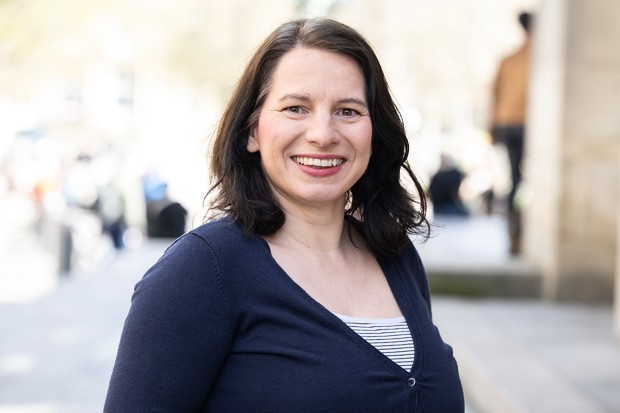Our Terms & Conditions | Our Privacy Policy
Annegret Richter • Artistic director, Stuttgart International Festival of Animated Film
“There’s no definition of which target group it has to be for; you can tell any story with stop motion”
02/05/2025 – The artistic director of one of the biggest festivals in Europe dedicated to animation filmmaking gives us the low-down on this year’s highlights

(© Reiner Pfisterer)
The next edition of the Stuttgart International Festival for Animated Film will take place from 6-11 May. We spoke to its artistic director, Annegret Richter, about this year’s highlights.
Cineuropa: Animation takes in many different techniques. This year, however, you are focusing on stop motion. Has this particular technique received a fresh boost recently?
Annegret Richter: In recent years, we have indeed noticed that more stop-motion films are being submitted. Of course, we have been wondering where the motivation for haptic, handmade work comes from. I can’t explain it. But I imagine that it could be a counter-movement to the digital processes. Animation has become so digital, with 3D or even AI. You can’t automate much in this haptic field of stop motion; you have to make individual images and frames. A lot of puppet making is still very personal, haptic and hands-on. We have stop motion in all areas. There’s no definition of which target group it has to be for; you can tell any story with stop motion.
How does the festival position itself in terms of its approach to the young audience?
The young audience is the target group of tomorrow. We are active in media education at a very early stage. We work together with schools and nurseries. We have free programmes for nurseries and offer the little ones their first cinema experience. There are school programmes with short films and feature-length movies. Our film Living Large [+see also:
film review
trailer
interview: Kristina Dufková
film profile], also a stop-motion film, tackling the important topic of obesity, is already sold out. As part of our open-air events, we also offer educational media programmes that families can use free of charge. The “Tricks for Kids” series includes international films that are spoken in German for the children, so that youngsters who cannot read yet can also be reached. Apart from this, the offerings for a young audience are integrated into the overall programme. We try to make the focus topics that we have for adults accessible to children as well.
In general, animated films are very expensive, and that’s why short-film formats play an important role. What role does a festival like Stuttgart play specifically for the careers of animation filmmakers in this field?
There are many people who only make short films and see their career in that domain, and of course, we also support them. We don’t assume that everyone wants to make features. For many types of movie, it’s not even possible from a financial point of view. Some stories are better told in short films, too. We try to give young talents who are new to the market many opportunities to network and further their education here in Stuttgart. This year, for example, we have the topic of international co-production, and we are providing information about the opportunities created by the new film-funding law in Germany. There are master classes and workshops; people should feel comfortable and get to know each other.
What’s next for the films after Stuttgart?
We are not a premiere festival, per se. But many people still like to celebrate their premieres with us because we invite a lot of “multipliers”, such as people from other festivals who bring films into their own programmes. We are also Oscar-qualifying, which means that the winner of our Grand Prix is on the Oscar longlist. In addition, the films in Germany get reference points because we are recognised on the [German funding system] list for short films. That’s important for the upcoming projects.
Is there a country that has stood out in recent years thanks to particularly interesting or new developments in its animation scene?
Hungary is getting stronger in animation. Pelikan Blue [+see also:
film review
trailer
interview: Laszló Csaki
film profile] is being shown as a feature-length film this year. Last year, the Hungarian short 27 (produced in France but by a Hungarian filmmaker) won our competition. There are some exciting styles that are also a bit unusual. We have to be careful that France doesn’t become too dominant in our programming because it has an incredibly strong film industry and opportunities owing to its financing structures, and is omnipresent in both the short and feature-film sectors. But apart from that, I have the feeling that many great works are being made in every country.
You have a focus on Switzerland this year. Can you tell us more about this?
For a country as small as Switzerland, it has an incredibly rich and wide range of films. We have been observing filmmaking in Switzerland for years and regularly show its movies in the competition. It’s great to now be able to highlight the different facets with a single focus. Our competition once again includes various Swiss shorts such as On Hold by Delia Hess and The Car That Came Back from the Sea by Jadwiga Kowalska. The fact that Savages [+see also:
film review
trailer
interview: Red Carpet @ European Film …
film profile] by Claude Barras was screened at Cannes last year was a particularly good hook. Switzerland is incredibly strong, both in the style that is being developed by its people and in the stories that are being told.
[ad_1]
Images are for reference only.Images and contents gathered automatic from google or 3rd party sources.All rights on the images and contents are with their legal original owners.
[ad_2]


Comments are closed.